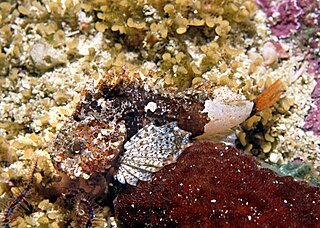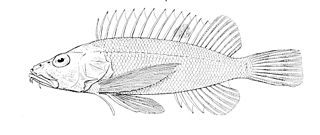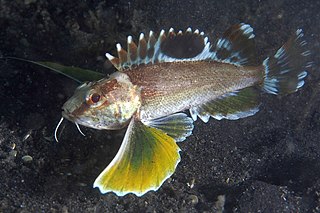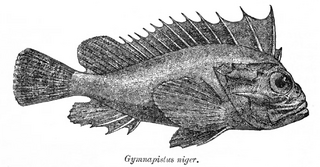
The South Australian cobbler, better known as the soldier but also known as the cobbler, devilfish or soldierfish, is a species of marine ray-finned fish, a waspfish, belonging to the subfamily Tetraroginae which is classified within the family Scorpaenidae, the scorpionfishes and their relatives. It is endemic to southern Australia. It is the only species in the monotypic genus Gymnapistes.

Apistinae, the wasp scorpionfishes, is a subfamily of venomous, marine ray-finned fishes belonging to the family Scorpaenidae, the scorpionfishes and related species. These fishes are native to the Indian Ocean and the western Pacific Ocean.

The leaf goblinfish is a species of marine ray-finned fish, a waspfish belonging to the subfamily Tetraroginae, which is classified as part of the family Scorpaenidae, the scorpionfishes and their relatives. This is the only species in the monotypic genus Neovespicula. It is found in coastal habitats of the Indo-West Pacific region.

Tetraroginae is a subfamily of marine ray-finned fishes, commonly known as waspfishes or sailback scorpionfishes, belonging to the family Scorpaenidae, the scorpionfishes and their relatives. These fishes are native to the Indian Ocean and the West Pacific. As their name suggests, waspfishes are often venomous; having poison glands on their spines. They are bottom-dwelling fish, living at depths to 300 metres (980 ft). These creatures usually live in hiding places on the sea bottom.

The smoothskin scorpionfish is a species of ray-finned fish, a waspfish belonging to the subfamily Tetraroginae of the family Scorpaenidae, the scorpionfishes and their relatives. It is the only species in the monotypic genus Coccotropsis. This species is endemic to the seas off South Africa.

Paracentropogon longispinis, the wispy waspfish, sailfin waspfish, whiteface waspfish or whiteface roguefish, is a species of marine ray-finned fish, a waspfish belonging to the subfamily Tetraroginae, which is classified as part of the family Scorpaenidae, the scorpionfishes and their relatives. It is found in the central Indo-West Pacific. It is the type species of the genus Paracentropogon.

Apistops is a monotypic genus of wasp scorpionfishes belonging to the subfamily Apistinae in the family Scorpaenidae, the scorpionfishes and their relatives. Its only species is the short-armed waspfish, also known as the shortfinned waspfish or shortspine waspfish. This species is found in the Indian and Pacific waters from Papua New Guinea, the Arafura Sea and northwest Australia. It is a demersal fish found on the inshore area of the continental shelf at depths between 19 and 49 m. This species grows to a length of 19 centimetres (7.5 in) SL.

Apistus is a monotypic genus of marine ray-finned fish belonging to the subfamily Apistinae, the wasp scorpionfishes, part of the family Scorpaenidae, the scorpionfishes and their relatives. Its only species is the Apistus carinatus which has the common names ocellated waspfish, bearded waspfish, longfin waspfish or ringtailed cardinalfish, has a wide Indo-Pacific distribution. This species has venom bearing spines in its fins.

Ablabys is a genus of marine ray-finned fishes, waspfishes belonging to the subfamily Tetraroginae, which is classified as part of the family Scorpaenidae, the scorpionfishes and their relatives. The fishes in this genus are found in the Indian Ocean and the western Pacific Ocean.

The marbled spinefish, also known as the yellow waspfish, is a species of ray-finned fish, a waspfish belonging to the subfamily Tetraroginae of the family Scorpaenidae, the scorpionfishes and their relatives. It is the only species in the monotypic genus Cottapistus. This species is found in the Indo-West Pacific.
Liocranium is a small genus of marine ray-finned fishes, waspfishes belonging to the subfamily Tetraroginae, which is classified as part of the family Scorpaenidae, the scorpionfishes and their relatives. The fishes in this genus are found in the eastern Indian Ocean and the western Pacific Ocean.
Neocentropogon is a poorly known genus of marine ray-finned fishes, waspfishes belonging to the subfamily Tetraroginae, which is classified as part of the family Scorpaenidae, the scorpionfishes and their relatives. The fishes in this genus are native to the Indian Ocean and the western Pacific Ocean.

Ocosia is a genus of ray-finned fishes, waspfishes belonging to the subfamily Tetraroginae, which is classified as part of the family Scorpaenidae, the scorpionfishes and their relatives. These fish are found in the Indian Ocean and western Pacific Ocean.

Paracentropogon is a genus of ray-finned fishes, waspfishes belonging to the subfamily Tetraroginae, which is classified as part of the family Scorpaenidae, the scorpionfishes and their relatives, These fish are found in the Indian Ocean and western Pacific Ocean.

Pseudovespicula is a genus of venomous ray-finned fishes, waspfishes belonging to the subfamily Tetraroginae, which is classified as part of the family Scorpaenidae, the scorpionfishes and their relatives. It has been considered to be a monotypic genus, containing only the type species, Pseudovespicula dracaena, but some authorities classify three species within the genus. The genus is found in the Indo-Pacific region.

Snyderina is a genus of ray-finned fishes, waspfishes belonging to the subfamily Tetraroginae, which is classified as part of the family Scorpaenidae, the scorpionfishes and their relatives. These fishes are found in the western Indian Ocean and the western Pacific Ocean.

Tetraroge is a genus of ray-finned fishes, waspfishes belonging to the subfamily Tetraroginae, which is classified as part of the family Scorpaenidae, the scorpionfishes and their relatives. These fishes are native to the Indian Ocean and the western Pacific Ocean.

Ablabys binotatus, the redskinfish, is a species of marine ray-finned fish, a waspfish belonging to the subfamily Tetraroginae of the family Scorpaenidae, the scorpionfishes and their relatives. This species is found in the Indian Ocean.

Ablabys macracanthus, also known as the spiny waspfish or as the spiny leaf-fish in Indonesia, is a species of marine ray-finned fish, a waspfish belonging to the subfamily Tetraroginae of the family Scorpaenidae, the scorpionfishes and their relatives. This species is found in the Western Pacific and Indian Oceans.

The mangrove waspfish, also known as the goblinfish, is a species of marine ray-finned fish, a waspfish belonging to the subfamily Tetraroginae, which is classified as part of the family Scorpaenidae, the scorpionfishes and their relatives. This species occurs in the Indo-Pacific region.

















